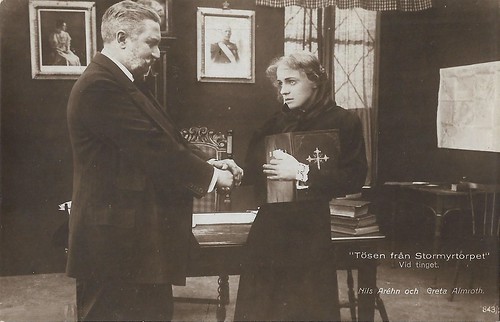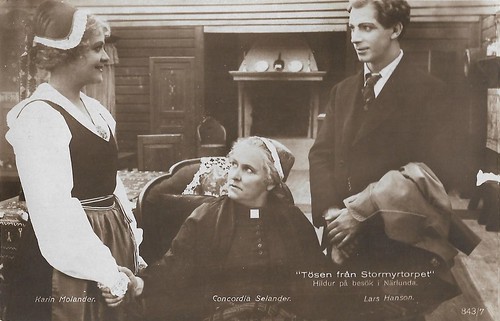
Swedish postcard by Nordisk Konst, Stockholm, no. 843/1. Photo: Svenska Biografteatern AB. Gösta Cederlund as Per Månsson, Greta Almroth as Helga and William Larsson as her father in Tösen från Stormyrtorpet/The Girl from the Marsh Croft (Victor Sjöström, 1917). The woman in the back may be Edla Rothgardt, who plays Per Månsson's wife. Caption: At the house of Per Månsson at Västgården.

Swedish postcard by Nordisk Konst, Stockholm, no. 843/2. Photo: Svenska Biografteatern AB. Greta Almroth as Helga and Nils Aréhn as the Judge in Tösen från Stormyrtorpet/The Girl from the Marsh Croft (Victor Sjöström, 1917). Caption: At the courtcase.

Swedish postcard by Nordisk Konst, Stockholm, no. 843/3. Photo: Svenska Biografteatern AB. Lars Hanson and Greta Almroth in Tösen från Stormyrtorpet/The Girl from the Marsh Croft (Victor Sjöström, 1917). Caption: Outside of the courthouse.

Swedish postcard by Nordisk Konst, Stockholm, no. 843/4. Photo: Svenska Biografteatern AB. Lars Hanson, Concordia Selander and Hjalmar Selander in Tösen från Stormyrtorpet/The Girl from the Marsh Croft (Victor Sjöström, 1917). Caption: Erlandsson at Närlunda.

Swedish postcard by Nordisk Konst, Stockholm, no. 843/5. Photo: Svenska Biografteatern AB. Greta Almroth, Concordia Selander and Hjalmar Selander in Tösen från Stormyrtorpet/The Girl from the Marsh Croft (Victor Sjöström, 1917). Caption: Sundays at Närlunda.
Profound intimacy
Helga Nilsson (Greta Almroth), the daughter of a poor farmer from the moors, starts working for Per Martinsson (Gösta Cederlund) as a maid. Although married, Martinsson cannot keep his hands off the pretty young maid and seduces her. When Helga becomes pregnant by him, however, Per abandons her and is even prepared to commit perjury in court when it comes to a lawsuit and, in the trial, to establish paternity. Helga is able to stop him at the last moment from swearing on the Bible that he is not the child's father and subsequently withdraws her complaint.
Gudmund Erlandsson (Lars Hanson), who attends the court hearing and is the future groom of the alderman's daughter Hildur Persson (Karin Molander), is deeply impressed by Helga's behaviour and tells his mother Ingeborg about Helga's fate. Before Helga can commit an act of desperation and kill herself in view of the "shame" of having borne an illegitimate child, Gudmund's parents take her on as a new maid on their farm. Gudmund's fiancée Hildur is the exact opposite of Helga: spoilt and exalted, and she meets Helga, whose good relationship with Gudmund is a thorn in her side, with increasing rejection. Thus Helga's stay with the Erlandssons is also only temporary.
Gudmund begins to drink without restraint in view of the fact that his future wife is doing worse and worse in comparison to Helga. In this state, he is involved in a violent scuffle one day, which ends fatally for Martinsson. When Gudmund wakes up the next morning, Per is dead, stabbed to death. Gudmund's knife blade is broken off, and Gudmund, who cannot remember anything due to alcohol consumption, then believes that he must have been the murderer of Helga's seducer. He confesses to his own father the crime he did not commit. When Hildur and her family learn of these circumstances, they immediately call off the upcoming wedding. Hildur now shows her true colours and has only contempt for her fiancé.
Gudmund, who is sure that he will now have to go to prison, visits Helga one last time and talks about the crime and the knife with the broken blade. Helga immediately realises that there has been a mistake and tells Gudmund that she herself broke off the blade when she used his knife for carving the day before. Although Helga loves Gudmund, she only wants his happiness, and since she does not want Gudmund's relationship with Hildur to fall apart because of this misunderstanding, she rushes to her to explain the true facts. Hildur, in turn, recognises in Helga's actions that Helga loves her ex and that she herself will never evoke such profound intimacy in Gudmund. And so she goes to him and tells the young Erlandsson about Helga's feelings. Gudmund, in turn, has long since realised that Hildur, who only speculated on his family's wealth, would have been the wrong choice of wife either way. Now, at last, the way is clear for a future together for Helga, the girl from the moors, and Gudmund Erlandsson.
Lars Hanson (1886-1965) was a highly successful Swedish film and stage actor mostly remembered for his motion picture roles during the silent film era, both in Scandinavia and Hollywood. Karin Molander (1889–1978), who plays Hildur, was a star in silent Scandinavian cinema and the real-life wife of Lars Hanson (Gudmund). In the films of Mauritz Stiller, the Swedish actress became a symbol of the modern, young and emancipated women of the 1910s. Swedish stage and screen actress Greta Almroth (1888-1981), who plays Helga was one of the Swedish silent cinema's first big stars. She participated in just over 30 films, including Hans Nåds testamente/His Grace's Testament (Victor Sjöström, 1919) and Prästänkan/The Parson's Wife (1920).
The film is based on the novel 'Tösen från Stormyrtorpet', published in 1908 in the collection 'En saga om en saga och andra sagor'and written by popular Swedish author Selma Lagerlof, who was receiving international attention as the first woman to get a Nobel Prize for literature. This was the first time she had one of her books made into a film. Tösen från Stormyrtorpet (Victor Sjöström, 1917) was originally released in the US as The Girl from the March Croft and the UK as The Woman He Chose. However it is today generally referred to as The Lass from the Stormy Croft, which is closer to the original Swedish title. Six other adaptions of the same novel have been made, a German and a Turkish in 1935, a Finnish in 1940, another Swedish in 1947, a Danish (Husmandstøsen) in 1952 and another German in 1958.

Swedish postcard by Förlag Nordisk Konst, Stockholm, no. 843/6. Photo: Svenska Biografteatern AB. Karin Molander in Tösen från Stormyrtorpet/The Girl from the Marsh Croft (Victor Sjöström, 1917). Caption: The alderman's daughter Hildur from Alvakra.

Swedish postcard by Nordisk Konst, Stockholm, no. 843/7. Photo: Svenska Biografteatern AB. Karin Molander, Lars Hanson and Concordia Selander in Tösen från Stormyrtorpet/The Girl from the Marsh Croft (Victor Sjöström, 1917). Caption: Hildur visits Närlunda.

Swedish postcard by Nordisk Konst, Stockholm, no. 843/8. Photo: Svenska Biografteatern AB. Karin Molander and Lars Hanson in Tösen från Stormyrtorpet/The Girl from the Marsh Croft (Victor Sjöström, 1917). Caption: Gudmund Erlandsson and Hildur Eriksdotter.

Swedish postcard by Nordisk Konst, Stockholm, no. 843/9. Photo: Svenska Biografteatern AB. Karin Molander in Tösen från Stormyrtorpet/The Girl from the Marsh Croft (Victor Sjöström, 1917). Caption: Hildur dressed up as bride.

Swedish postcard by Nordisk Konst, Stockholm, no. 843/10. Photo: Svenska Biografteatern AB. Karin Molander and Greta Almroth in Tösen från Stormyrtorpet/The Girl from the Marsh Croft (Victor Sjöström, 1917). Caption: Alderman's daughter Hildur and the Marsh Girl.
Sources: Wikipedia (English and Swedish) and IMDb.
No comments:
Post a Comment